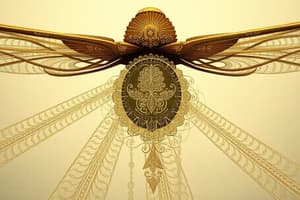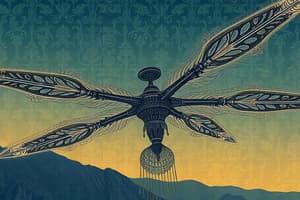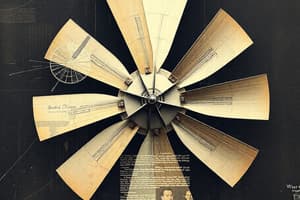Podcast
Questions and Answers
What is the primary distinction between a symmetrical and an asymmetrical rotor blade?
What is the primary distinction between a symmetrical and an asymmetrical rotor blade?
- Symmetrical blades have an upper and lower surface that are identical, while asymmetrical blades have different upper and lower surface shapes. (correct)
- Symmetrical blades have a flat black paint finish, and asymmetrical blades don't.
- Symmetrical blades have a stainless steel capping on the leading edge, whereas asymmetrical blades do not.
- Symmetrical blades are tapered, and asymmetrical blades are parallel.
Which blade type offers a better aerodynamic pitching characteristic?
Which blade type offers a better aerodynamic pitching characteristic?
- Uniform
- Tapered
- Asymmetrical
- Symmetrical (correct)
How do engineers achieve comparable aerodynamic pitching characteristics in an asymmetrical blade?
How do engineers achieve comparable aerodynamic pitching characteristics in an asymmetrical blade?
- By sweeping the trailing edge 3 degrees upward. (correct)
- By adding a static discharge mechanism.
- By making the blade out of composite material.
- By using a heavier leading-edge material.
What is the main reason why manufacturers prefer using uniform planforms for rotor blades?
What is the main reason why manufacturers prefer using uniform planforms for rotor blades?
Which rotor blade planform is designed to produce even lift without corrections?
Which rotor blade planform is designed to produce even lift without corrections?
What is the purpose of a negative twist in the blade of a rotor with a uniform planform?
What is the purpose of a negative twist in the blade of a rotor with a uniform planform?
What feature is commonly found on the leading edge of all rotor blades?
What feature is commonly found on the leading edge of all rotor blades?
What specific characteristic is required in composite rotor blades?
What specific characteristic is required in composite rotor blades?
What is the primary inspection method used for rotor blades?
What is the primary inspection method used for rotor blades?
Which type of rotor blade construction is easier to manufacture?
Which type of rotor blade construction is easier to manufacture?
Where are spanwise balance weights located on the rotor blade?
Where are spanwise balance weights located on the rotor blade?
What effect does adding weight to the forward position of trim balance weights have?
What effect does adding weight to the forward position of trim balance weights have?
What is the first system to rig during the rigging process?
What is the first system to rig during the rigging process?
Which types of balance weights are movable during repair?
Which types of balance weights are movable during repair?
What is a purpose of trim tabs on a rotor blade?
What is a purpose of trim tabs on a rotor blade?
What characteristic describes the leading edge of a rotor blade?
What characteristic describes the leading edge of a rotor blade?
Flashcards
Symmetrical rotor blade
Symmetrical rotor blade
The upper and lower surfaces of the blade are identical.
Asymmetrical rotor blade
Asymmetrical rotor blade
The upper surface has a higher camber (curvature) and the lower surface is flatter.
Aerodynamic Pitching Characteristics
Aerodynamic Pitching Characteristics
Symmetrical blades have better aerodynamic pitching characteristics.
Lift Production
Lift Production
Signup and view all the flashcards
Uniform Planform
Uniform Planform
Signup and view all the flashcards
Tapered Planform
Tapered Planform
Signup and view all the flashcards
Negative Twist
Negative Twist
Signup and view all the flashcards
Leading Edge Protection
Leading Edge Protection
Signup and view all the flashcards
Bonding Strips
Bonding Strips
Signup and view all the flashcards
Bonded Construction
Bonded Construction
Signup and view all the flashcards
Single-Pocket Rotor Blade
Single-Pocket Rotor Blade
Signup and view all the flashcards
Multi-Pocket Rotor Blade
Multi-Pocket Rotor Blade
Signup and view all the flashcards
Spanwise Balance Weights
Spanwise Balance Weights
Signup and view all the flashcards
Chordwise Balance Weights
Chordwise Balance Weights
Signup and view all the flashcards
Tracking Balance Weights
Tracking Balance Weights
Signup and view all the flashcards
Collective Rigging
Collective Rigging
Signup and view all the flashcards
Study Notes
Rotor Blade Design
-
Symmetrical vs. Asymmetrical Blades: Symmetrical blades have identical upper and lower surfaces, while asymmetrical blades have a higher camber on the upper surface and a flatter surface on the bottom. Symmetrical blades are better for aerodynamic pitching, while asymmetrical blades produce more lift for the same area. Engineers achieve comparable pitching characteristics on asymmetrical blades by sweeping the trailing edge upward by 3 degrees.
-
Common Blade Design: Symmetrical design is more common, although manufacturers are increasingly using asymmetrical designs.
-
Planform Types: Two main planform types exist:
- Parallel/Uniform: The leading and trailing edges run parallel to each other, and the chord (width) is consistent from root to tip. Benefits include cost-effectiveness due to simplified manufacturing (reuse of ribs).
- Tapered: The leading and trailing edges converge towards the tip, and the chord length decreases towards the tip. Produces lift more evenly across the blade without corrective measures, though lift production is unequal across the blade at different rotational speeds.
-
Compensation for Uneven Lift: Uniform planform blades produce more lift at the tip than the root. Engineers compensate by adding negative twist to the blade. This adjusts the angle of attack (AOA) at different points along the blade to maintain equal lift production at differing speeds. Tapered plans compensate for speed variation with variable chord lengths, ensuring a more even lift distribution.
Rotor Blade Materials and Construction
-
Leading Edge Material: All rotor blades have stainless steel caps for protection against erosion from dust particles during flight. These materials improve durability and lifespan.
-
Rotor Blade Painting: The bottom of rotor blades is painted black to prevent glare and its effect on the pilot's visibility.
-
Static Discharge on Composite Blades: Composite blades require reinforcement against static electricity by extending bonding strips from tip to root to redirect any static build-up to the airframe.
-
Blade Material Options: Rotor blades can be made from metal, composite materials, or wood.
-
Inspection Method: Tap testing is a primary method for inspecting composite rotor blades.
-
Contruction Types: Bonded construction is preferred for its strength over alternative mechanical fastening methods. Single-pocket design is easier, quicker, and less complex for manufacturers to build. Multi-pocket designs require precise jigs for alignment and are more complex to produce initially, but are easier and less expensive to repair compared to single-pocket designs.
Rotor Blade Balance and Rigging
-
Balance Weights: Rotor blades have spanwise, chordwise, and tracking mass balance weights.
- Spanwise balance weights are located center to tip.
- Chordwise balance weights are on the leading edge, typically between 30% and 50% of the chord length.
- Tracking balance weights are located on the leading and trailing edges of the tip portions.
-
Servo Tabs: These trailing edge tabs control blade angle of attack, making the blades smoother to control and increasing both efficiency and ease of control. They also reduce and stabilize vibrations.
-
Rigging Procedures: Rigging starts with the collective system and is followed by the correlator (or auto-throttle system), if the aircraft has one. The aircraft is rigged with the lowest possible weight to ensure the rotor's speed is adequate for the angle of attack.
Studying That Suits You
Use AI to generate personalized quizzes and flashcards to suit your learning preferences.




